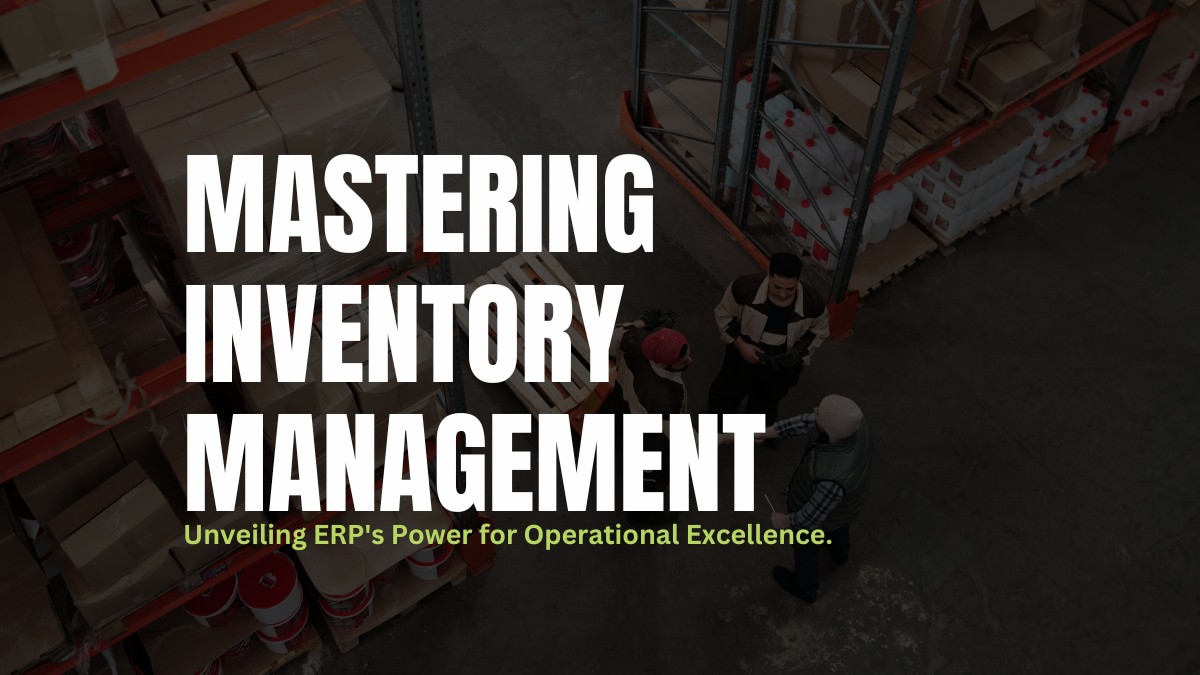Efficient inventory management is the backbone of any successful business. When integrated into an ERP software, it becomes a powerhouse of streamlined operations. Dealing with inventory, you are going to face a lot of challenges during the execution process. In this blog, we’ll explore the complexities of inventory management within an ERP software, the challenges it helps overcome, and the ways it transforms business processes.
Challenges
- Inconsistent Tracking: Lack of real time visibility into inventory levels, movements, and sales can hinder decision making and responsiveness.
- Warehouse efficiency: When a warehouse is inefficient it can lead to problems such as inaccurate inventory counts, misplaced items and increased operational costs.
- Inaccurate data: Predicting demand and aligning inventory levels with actual requirements can be challenging without accurate data and analysis.
- Changing demand: Changing demand typically necessitates adjusting inventory management strategies. If demand increases, you might need to reorder stock more frequently to prevent stock outs. If demand decreases, you might need to adjust order quantities to prevent excess inventory buildup.
- Manual Processes: Traditional methods of inventory management involving spreadsheets and manual data entry are error prone and time consuming.
- Supply chain complexity: Supply chain complexity refers to the intricacy and inter dependencies within the various stages of a supply chain, including suppliers, manufacturers, distributors and retailers. This complexity can significantly impact inventory management by making it more challenging to accurately forecast demand, coordinate demand, coordinate production and deliveries and managing inventory levels effectively.
- Overstocking: Discrepancies between physical inventory and recorded data can lead to stock outs or overstocking, affecting customer satisfaction and profitability.
- Inefficient process: Businesses operating across multiple locations struggle with coordinating inventory movements, leading to inefficiencies.
- Inadequate software: Managing inventory in inadequate software can lead to delays, overstocking, and understocking. Also, it leads to customer dissatisfaction due to mismanagement and lack of proper tools.
Solutions
- Centralised Tracking: Inconsistent tracking in inventory management can be resolved by implementing a robust inventory management software that integrates real-time data syncing, barcode scanning, and automated alerts for stock levels.
- Demand forecasting: Demand forecasting is a crucial tool in inventory management. Accurate forecasts enable businesses to maintain optimal inventory levels, preventing both overstocking and understocking. Additionally, it helps streamline the supply chain, reducing production and transportation bottlenecks.
- Preventive Control: Preventive controls involve strategies and processes that help prevent problems such as stockouts, overstocking, theft, and obsolescence. By employing methods like demand forecasting, setting reorder points, implementing quality checks, and using accurate tracking systems, preventive controls ensure that inventory levels are maintained optimally, reducing costs, improving customer satisfaction, and enhancing overall operational efficiency.
- Classify Inventory: Classifying inventory helps prioritise which items should be reordered first. Businesses can apply different replenishment strategies based on the classification, potentially reducing carrying costs.
- Multi-location Warehousing: Multi-location warehouse management can be solved through various strategies. Optimizing inventory placement and movement in a multi-location setup ensures timely fulfillment, minimized holding costs, and streamlined operations, ultimately enhancing customer satisfaction and overall profitability.
- Dashboard Collaboration: A dashboard collaboration for inventory management is a digital interface where team members can work together overseas and control inventory related tasks and data. It typically includes real time updates, analytics and tools for efficient inventory tracking, ordering and optimisation.
How ERP helps in Inventory Management
- Automated Data Entry: Automated data entry minimizes manual input, reduces the risk of human errors such as typos and miscalculations. This ensures that inventory data is consistently accurate, providing real-time updates on inventory levels and enabling businesses to make informed decisions about restocking, reordering, or optimizing stock levels. ERP systems can automatically track items as they move through the supply chain, from procurement to sales, reducing the time and effort required for manual data entry.
- Reducing Errors: With an ERP, you can track the status of purchase orders, sales orders, and shipments in real-time. This helps minimize errors related to order fulfillment. ERP systems facilitate regular inventory reconciliations, comparing physical stock levels. Any discrepancies can be quickly identified, reducing errors going unnoticed. ERP systems allow you to set user permissions and audit trails, reducing the likelihood of unauthorized alterations or deletions.
- Department Coordination: ERP software acts as a unifying force within an organization’s inventory management efforts. ERP fosters collaborations among departments by providing a shared platform for data and insights. This improves coordination when making critical decisions such as bulk ordering or inventory reductions. It also helps in tracking inventory levels, orders, and stock movement across departments. This ensures that all teams have accurate and up-to-date information.
- Predicting Supply and Demand: This process optimizes inventory levels, reduces carrying costs, and ensures products are available when needed. ERP systems leverage algorithms and data analysis to make accurate predictions, helping businesses effectively manage their resources and meet customer demand.
- Traceability: Traceability in Inventory Management with the help of ERP involves the ability to track and trace the movement and history of individual items or batches within your inventory system. ERP systems provide this capability through integrated software modules and databases that capture and store data related to inventory transactions. One of the important features is batch tracking, which is crucial for industries like food and pharmaceuticals. You can track the origin of specific batches, including suppliers, production dates, and expiration dates.
- Financial Reporting: ERP systems support different inventory valuation methods like FIFO (First-In-First-Out) or LIFO (Last-In-Last-Out). It allows businesses to choose the method that aligns with their financial goals. Additionally, financial statements like balance sheets and income statements that reflect the current state of inventory help businesses assess their financial health.
In conclusion, ERP systems play a pivotal role in enhancing inventory management. With the help of Quarto ERP, you can get real-time visibility into inventory levels, automating processes and facilitating data-driven decision-making. This enables businesses to optimize stock levels, reduce carrying costs, minimize stockouts, and ultimately improve overall operational efficiency and customer satisfaction.
Ready to enhance your inventory management operations with our ERP software? Contact us today.





